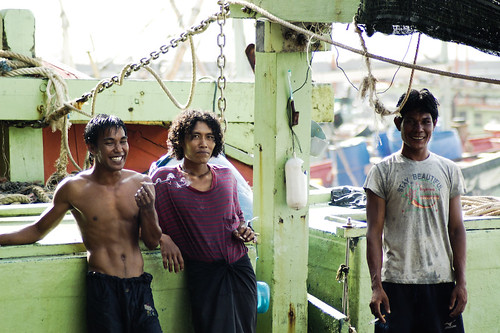Cigarette for breaks (_DSC1535)
Tired after unloading the catch from the whole week at open sea they stopped and took a few puffs for a break.
Taken with a Nikon D50 and AF Zoom-Nikkor 70-300mm f/4-5.6G lens
Location: Chendering Fisheries Garden, Kuala Terengganu, Terengganu, Malaysia
The problem with all types of film and recording media is that they cannot record the entire range of contrast (black to white) that the eye can see. Especially when you take into account that the eye is constantly adjusting to cope with high contrast. On a sunny day if you look into the shadows of a scene then into the bright areas, the iris in your eye will quickly adjust so you can see detail in both.
Faced with the task of recording as much information as possible, the camera will try to average out all the light levels and expose the film accordingly. As burnt out highlights are normally considered uglier than black shadows, the camera, left to it's own devices will normally err on the dark side. Which is no good if you are shooting someone's face against a bright sky. It's the person's face you want to see, and you don't really care if the sky is white.
Exposure Correction can Work as an ISO Sensitivity Adjustor
When taking pictures of dark objects or taking high-speed pictures with a telephoto lens, high-sensitivity settings are needed. The aperture is fully open, but the speed is not sufficient and my camera's specifications are limited. In such cases, it is necessary to increase the ISO sensitivity.
However, adjusting the ISO sensitivity is complicated with most cameras. Exposure settings, though, are very easy to operate. Therefore, you can underexpose your pictures without having to adjust the ISO sensitivity, allowing you to overcome aperture and shutter speed problems. This technique can only be used with RAW photography.
It is possible to adjust sensitivity during development of RAW pictures. You will be able to achieve the same results, or possibly better results, as when adjusting the ISO on the camera. If you set your camera to take RAW pictures, exposure correction can be used to adjust ISO sensitivity.
Labels: AF Zoom-Nikkor 70-300mm f/4-5.6G, Chendering Fisheries Complex, Nikon D50, People, Photography
